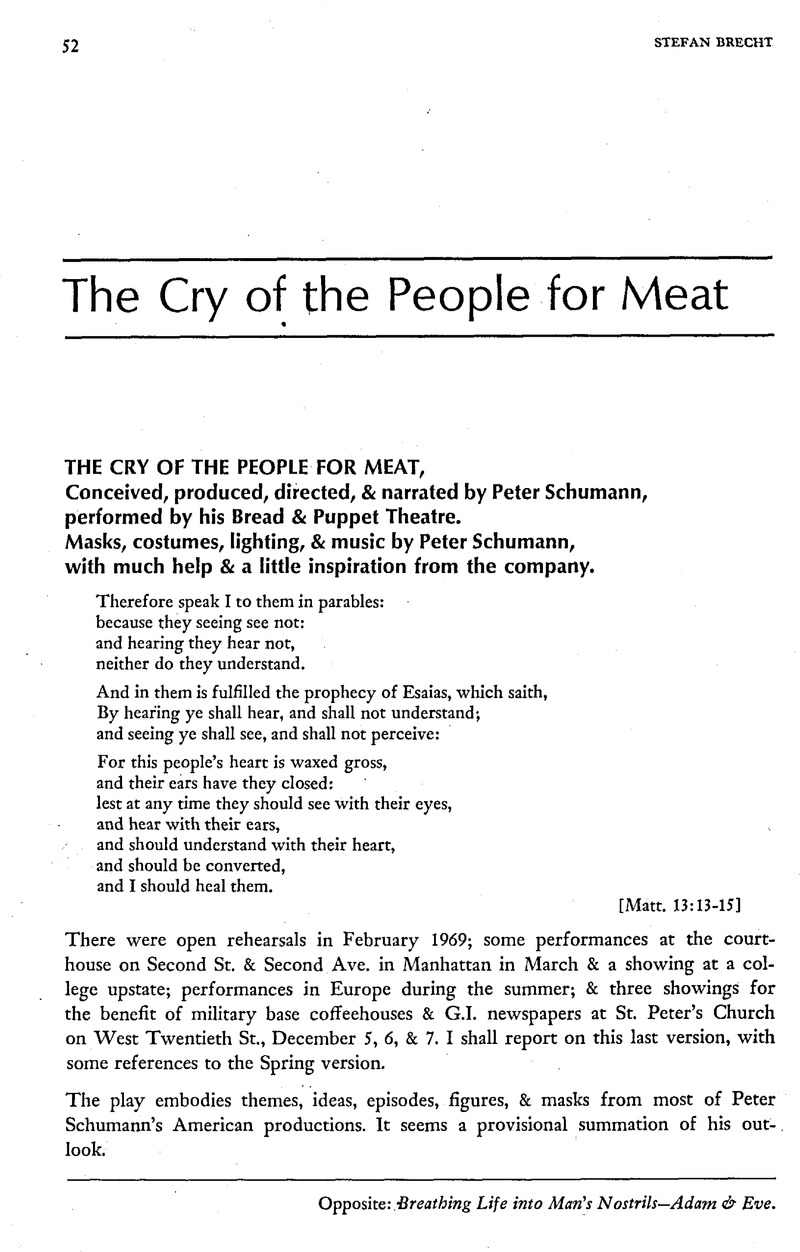No CrossRef data available.
Article contents
The Cry of the People for Meat
Published online by Cambridge University Press: 07 December 2021
Abstract

- Type
- Peter Schumann's Bread & Puppet Theatre
- Information
- Copyright
- Copyright © 1970 The Drama Review
References
1 According to Schumann the full scene is actually: the cowed beast crawls up to Adam & Eve, is born as Cain was before, they pull his mask off, Adam pulls him—Eve's second born, Abel—over to Cain, he writes “Cain” in red on Cain's forehead. Then, with the mark of Cain on him, Cain proceeds to kill Abel. But what I saw renders the essence, which shows that the symbolic efficacy of the staging is independent of its parabolic clarity.
2 In the earlier versions, the Flood is more dramatic. The crowd runs back from the screen. They don the beast-masks & approach again, as beasts. Schumann, behind the Angel on whose swords the projector hangs, manipulates him like a human puppet, wrestling him backward & forward by his shoulders so that the projector lights the advancing tangle of beasts. Thunderous sounds, growls. Schumann draws the Angel before them, lifts him up high, illuminating the floor messy with newspaper strips. The beasts collapse on the floor, white masks, giant heads all over. A field of wreckage. God the killer.
3 In the spring version, this scene was a horrible & tragic spectacle. Schumann, with the cricketinstrument, read the begats in darkness, with two slowly flashing strobe-lights illuminating the advance of the groups amidst the eery litter of paper debris & thrown-off beast-masks, a couple acting out each begat: rising together, struggling, falling again: cohabitation, procreation, death in a desperate fusion of orgasm & agony in which death not only wins out over sex, but inhabits it, corroding life, a turgid struggle forever lost.
4 The back of the head appears first, then the face—he was looking the wrong way. One sniffs a little. One waves his hand hello. One leaves suddenly as though called away. One comes in very very slowly, but disappears immediately when he sees the audience. David & Solomon: David's face, very big, rises, Solomon, smaller, steps out in front of it. Abraham & Isaac: two white faces, the one growing out of the other, rising behind it. A king rides out in front of the screen on a beast, then the beast comes out, riding on the king. A blue lady pushes a little miserable old man puppet out on a chair. A small man, naked on top, with enormous feet, he is all feet, comes out, takes a bow for his feet. A little hand puppet cop comes out, then a much bigger cop, about two feet tall.
5 In the earlier versions, Joseph's dressing did not end up funny. Furthermore, it was rendered awful by a screaming—a wailing, howling—at first rebellious, challenging, then more plaintive, which was kept up continuously by an uncostumed girl off to one side under a sign, “Earth.” This Voice of the Earth gave the ceremony a transcendental dimension. The girl left the company & nobody else could do it, but, in any event, now Earth no longer calls for or takes notice of the Change of,the Times. When Joseph drummed, the screen dropped, the Lord—actually Uranos—was revealed. Joseph shielded his eyes, the Blue Mary came forward, enormous in the light, her right arm in a splendidly angular gesture.
6 The spring action-outline is different, from Mary's getting into the pole-puppet onward:
The people get back into the beast-heads and, simultaneously, colored blankets are placed on two of the beasts; the narrator sweeps a path through the shredded paper; a length of green fabric is unrolled along the cleared path; Mary & Joseph mount the beasts; the people who assist Mary & Joseph put on colorful robes, string bells around the necks of some of the beasts & walk along as Shepherds beside and behind Mary & Joseph, in a procession that slowly crosses the stage to the far side, along a green path, to where a woman who has been shrieking awaits them.
Suddenly a musical chanting is heard from the other side of the stage, the Three Kings appear, riding a beast & traveling the same path the procession had followed. Mary & Joseph & the Shepherds join the Three Kings in the chant.
The light is cut; a red & green flicker light comes on, aimed at the far side of the stage. From under the red screen crawls a fantastic dragon bearing a white-painted baby in its mouth. The dragon crawls very closely across the stage to Mary's feet. Throughout this scene can be heard the gentle noises of woodland creatures, birds, crickets, & frogs. The woman who has been howling steps forward & takes the baby from the mouth of the dragon. The light is cut.
7 In the early versions of the play, the beatitudes were introduced by a light-feast. The performers assembled stage-center wearing the beast-masks. The amplifier mooed, lowed, the sound gradually growing into a wordless chant. It was dark but Schumann could be seen among his beasts, gesturing. A candle projected a shadow of his arm across half the ceiling. Gradually, more & more candles were lit, finally there were hundreds. Then all the houselights went on.
8 Schumann has preferred Luke's “blessed are the poor” to Matthew's “blessed are the poor in spirit.” Though the Sermon on the Mount is more “social” in Luke 6:20-21, Schumann quotes Matthew 5:3-10, for the other beatitudes.




